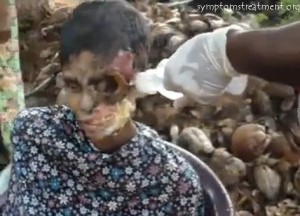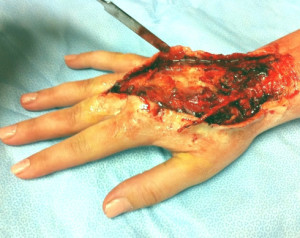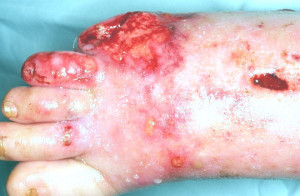What is Necrotizing Fasciitis ?
Necrotizing fasciitis is a bacterial infection wherein the soft tissues are slowly eaten away by bacteria. Necrotizing comes from the root word “necrosis” meaning death, and fasciitis comes from the word “fascia” or the smooth tissue covering of the muscles. This is a rare, life threatening condition that could only happen when a lesion or opening on the skin is present. For instance, it could happen after a person encounters an accident or injury that opens up a wound through which bacteria can enter. This could also occur with people who underwent surgery, women who gave birth, or anyone who has undergone a procedure that would require one to be opened up. If the infected person will not be given the proper antibiotics as prophylactic for bacterial infection, necrotizing fasciitis can happen.
Causes of necrotizing fasciitis
There are a number of bacteria that can cause necrotizing fasciitis. The most commonly reported is the Strep A bacteria or Streptococcus pyogenes that could also cause strep throat. Necrotizing fasciitis would occur when the bacteria make their way into the body through an open wound. The bacteria would slowly eat up the tissue and immerse themselves into the bloodstream where they would release toxins which are spread throughout the body. Once this happens, other diseases could also arise which would pose a threat to the person’s health.
Below are some factors that may also contribute to the development of necrotizing fasciitis:
- An open wound that is exposed to dirty water or pool that is contaminated with invasive bacteria.
- Incidents that might strain the muscles, like getting punched hard on the shoulder or having a heavy object fall on one’s legs, could also cause necrotizing fasciitis even if there is no open wound present. These cases are rare but still possible.
- Any type of surgery such as abdominal surgery, plastic surgery and intestinal surgery could give rise to necrotizing fasciitis. This likewise includes giving birth either normally or through caesarean section.
- An untreated wound, especially for diabetic patients. In the case of diabetics, their wounds do not heal right away. Bacteria could settle on the lesion and eat away the tissues. If not given immediate medical attention, amputation of the infected part might need to be done in order to prevent the bacteria from spreading any further into the bloodstream.
Symptoms of necrotizing fasciitis
Bacteria can dangerously spread through the bloodstream within the day. So it is really vital to know the different symptoms of necrotizing fasciitis so that proper action can be taken on time.
- The skin on the affected area would turn warm and red, and somewhat bumpy at times.
- The bruise could dangerously become bigger in less than an hour.
- The center of the wound or bruise would turn black and pus could break out from the wound.
- The patient may experience shock due to gangrene. Gangrene is the term for damaged fats, tissues and kin.
- Other indications include nausea, vomiting, chills, weakness, dizziness, fever and diarrhea.
Once the symptoms are detected, it is imperative to seek medical attention immediately to prevent the condition from worsening or becoming fatal.
Necrotizing fasciitis diagnosis
The doctor would run some tests, including complete blood count and skin tissue biopsy, in order to detect the severity of the case and to know what type of bacteria has caused the infection. This way, the most suitable kind of antibiotics can be given to the patient. CT scan, MRI and X-ray could also be conducted to precisely see how far the damage has gone or which parts of the body have been infected.
Necrotizing fasciitis treatment
As for the treatment, the patient would be advised to be confined in the hospital so that proper monitoring of the progress of the patient and how well the patient responds to the medications can be done. Intravenous broad spectrum antibiotics will be administered to quickly and effectively kill the bacteria. Furthermore, surgery is recommended to remove the dead and infected tissues to prevent further infection to other parts of the body. In severe necrosis of the tissues, removal of the infected body part or amputation may be done. For patients who are in shock, inhalation of 100% oxygen would help in the treatment.
Other treatment options include hyperbaric oxygen therapy which would greatly aid in the faster healing of wounds and prevent further death of the skin tissue. If the skin on the infected part is already dead due to infection, a skin graft may be performed to replace the dead skin and to promote healing of the area.
Necrotizing fasciitis is a silent killer. It could begin to enter through a small wound but can result to great harm and even death. This disease could easily be treated if detected during the early phase. The best thing to do to prevent necrotizing fasciitis from happening is to be healthy, practice good hygiene and treating wounds or cuts right away to prevent infection.
Necrotizing Fasciitis pictures


